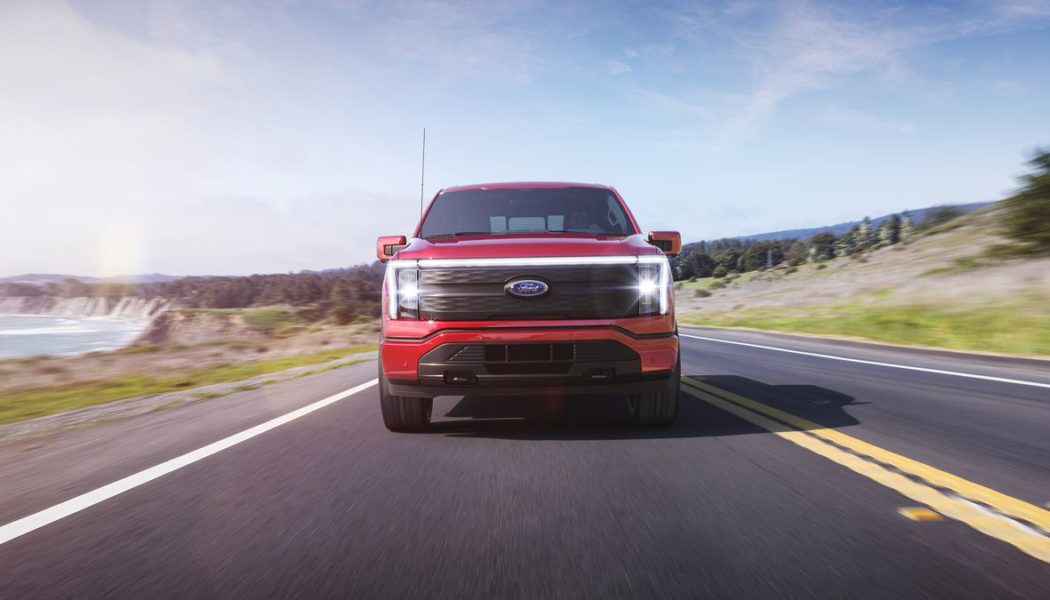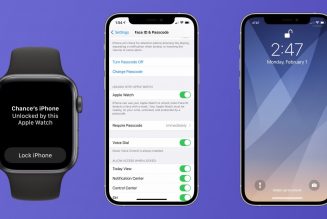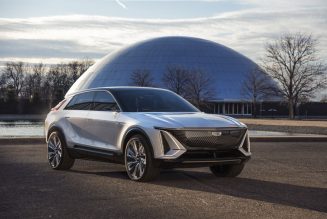The most popular vehicle in the United States is going electric. Ford has revealed the F-150 Lightning, an all-electric version of its popular pickup truck due out in 2022, and it’s aggressively priced for an EV. The base model with 230 miles of range starts at $39,974, while the extended range version starts in the mid-$50,000s and can go about 300 miles.
That puts it right on par, price-wise, with Tesla’s Cybertruck and far below more luxury-minded options like Rivian’s R1T or General Motors’ exorbitant GMC Hummer pickup. And since Ford’s vehicles are still eligible for the full $7,500 federal tax credit, that price tag can essentially come down even more for early buyers. It’s especially stunning, though, because all variants of the F-150 Lightning are built with Ford’s four-door “SuperCrew” cab, the gas version of which starts at $36,650. The base model Lightning is even slightly cheaper than its comparable hybrid F-150 counterpart. Most electric vehicles to date have cost more than their gas counterparts, but Ford is the closest to bucking that trend. Ford has already started taking reservations for $100.
There are a few sacrifices in that base model aside from range, but nothing that seems terribly prohibitive. And while sticker price isn’t everything when it comes to electric vehicles, it is a big barrier for many buyers. The F-150 Lightning’s price goes up with added features and extra range, but from what Ford revealed Wednesday night, the company looks ready to convince a wide swathe of customers to consider electric when they go to buy their next F-150, with little regard to what price point they’re shopping at.
Those willing to make the jump will find a truck overflowing with utility features, including a lot of ideas that Ford has already offered on the gas-powered model (like a fold-out center console work surface) and the hybrid version (like the onboard charger). It has a few unique tricks that may make buyers who are skittish about range or price think twice, too. And it all comes wrapped in an exterior design that is almost indistinguishable from its internal combustion counterparts, save for a new grille with a striking continuous light bar.
In fact, the F-150 Lightning is by far the most familiar-looking of the electric pickups announced to date. And Ford is betting big that this unchallenging boxy design — which Elon Musk poked fun at during the Cybertruck announcement in 2019 — will pay off.
“There’s plenty of space for everybody. What matters is we’re all true to ourselves,” Darren Palmer, the head of Ford’s EV division, told The Verge in an interview. “I think there’s enough to tempt people to look at [buying the electric version], and a good percent already were — we saw that in our research. But I think it’s going to tempt people who weren’t even looking.”
Or as Ford CEO Jim Farley said on The Verge’s Decoder podcast, which comes out Thursday morning: “There are lots of flavors of soda, but there’s only one Coke, and there’ll be lots of electric pickup trucks, [but] there’s only one F-150.”
:no_upscale()/cdn.vox-cdn.com/uploads/chorus_asset/file/22526645/3_16x9.jpg)
Power play
The F-150 Lightning comes in two battery configurations. The company says the standard range battery should get around 230 miles of range, while the extended range battery should be good for 300 miles (though neither spec has been officially rated by the Environmental Protection Agency yet).
Either of those configurations should be good for most daily driving scenarios, though many people will want to do typical truck things with the F-150 Lightning that are naturally more energy-intensive, like towing, hauling, or off-roading. To put those potential owners’ minds at ease, Ford says the truck’s software can provide real-time range estimates, something it’s already been working on in the Mustang Mach-E. This software factors in not just weather and traffic conditions, but it also uses an onboard scale to measure the weight of any payload or towing weight.
Ford announced last month that it was bringing this onboard scale technology to all F-150s, though it seems particularly useful for the Lightning — especially since Ford hasn’t compromised a ton on towing or payload capacity with its first serious electric truck. (Hi, Ford Ranger EV.)
The extended range Lightning is able to tow up to 10,000 pounds, which is more than what most affordable gas-powered F-150s are capable of, though it’s a few thousand pounds shy of what the F-150 hybrid or the diesel version can tow. The standard range F-150 Lightning, meanwhile, maxes out at 7,700 pounds.
But because of the weight difference in the battery packs, the standard range Lightning wins out on payload capacity, as it can carry up to 2,000 pounds versus the extended rage’s 1,800-pound max. Still, these figures fall roughly in the middle of what you can find across the full range of F-150s. (Larger F-Series trucks, of course, can pull and haul more — no word on when those might get electrified just yet.)
All versions of the F-150 Lightning will put their battery power down via two electric motors — one up front and one in back — meaning every buyer gets an all-wheel drive setup. The extended range version sounds like it could easily knock the wind out of you, with 420kW of total power (563 horsepower) and 775 pound-feet of torque. That’s good enough to make it the quickest F-150 ever made, with the ability to go from 0 to 60 miles per hour in the mid-4 second range. The standard range Lightning isn’t much worse off, with 318kW of power (426 horsepower) and the same amount of torque.
That all sounds fun (and also a little bit ludicrous for a big truck), but all this power is only so good as long as you can easily charge the electric F-150 back up. Charging is still a sore spot for most EVs, and it’s what sapped some of the fun out of my time with the Mustang Mach-E. The truth is, unless Ford invests in building out its own dedicated network, there’s only so much the company can do between now and when the Lightning hits the road to make the public charging experience better.
In the meantime, Ford’s band-aid solution is that it has coalesced a handful of disparate independent public charging networks into what it calls the FordPass Charging Network. All of these chargers show up in the FordPass smartphone app as if they are one large network, and Ford is even working with some so that owners don’t need to create new accounts or download other apps to start charging. It’s a great idea in theory, but it needs more work — hopefully progress can be made by the time the F-150 Lightning hits the road.
The quickest option to recharge the F-150 Lightning is at a 150kW DC fast charging station. At one of these plugs, the F-150 Lightning with the extended range battery can take on about 54 miles of range in 10 minutes and can charge from 15 percent to 80 percent in 41 minutes. The standard range battery will take longer, though: it can take on 41 miles of range in 10 minutes at a 150kW charging station, and it takes 44 minutes to charge from 15 to 80 percent.
:no_upscale()/cdn.vox-cdn.com/uploads/chorus_asset/file/22526676/5_16x9.jpg)
At home, a 120-volt outlet will trickle 3 miles per hour into the battery, while a 240-volt outlet can add around 14 miles per hour. The real standout charging feature is exclusive to the versions of the F-150 Lightning powered by the extended range battery. Ford is including a new 80-amp home charging station that not only fully charges the F-150 Lightning in eight hours but allows owners to easily power their entire home for around three days in the event of an electricity outage.
The ability to draw power from the battery pack isn’t limited to these extreme scenarios, though. All of the base trims of the F-150 Lightning can put out 2.4kW of onboard power, and the more expensive Lariat and Platinum trims offer a total of 9.6kW of onboard power. The more expensive F-150 Lightnings have 11 built-in power sockets — seven in the cab and bed, including a 240V outlet, and four in the front trunk — plus a handful of USB ports. Ford began playing with this idea of turning a vehicle into a mobile generator of sorts with the F-150 hybrid, but the higher trims of the F-150 Lightning will offer even more onboard power, and they won’t use gas to generate it. That’s not only a great feature for anyone who needs power on the go, but it could be a huge benefit for fleet operators or small businesses looking to go green.
“We think this is going to be really popular,” Palmer says. “People like to be self reliant. And this makes you completely self reliant.”
:no_upscale()/cdn.vox-cdn.com/uploads/chorus_asset/file/22526654/21_16x9.jpg)
Electric utility, future tech
Speaking of that front trunk, it’s huge. Ford says it can fit two sets of golf clubs or a large suitcase and two carry-on-sized bags. It has a total volume of 14.1 cubic feet (400 liters) and can carry up to 400 pounds of stuff. Like the front trunk on the Mustang Mach-E, it’s water resistant and has a drain for easy cleaning. Ford calls it — seriously — the Mega Power Frunk.
The F-150 Lightning’s front trunk is not only large, but the hood takes the truck’s grille with it when it opens, meaning you won’t have to reach up and over to access what’s inside. It’s a considerate touch from Ford, but it’s not terribly surprising considering the myriad utility features the company has built into recent F-150s — many of which carry over to the Lightning.
Beyond the frunk and the outlets and onboard power, there’s also the fold-out workstation in the center console, which has enough space for a laptop, a pad of paper, or your lunch. For people who spend a lot of time in their trucks — while charging, perhaps — the two front seats can fold back pretty much totally flat. And for people who do a lot of towing, the truck has Ford’s new smart hitch assist feature that can pretty much automatically hook a trailer up for you.
In fact, the Lightning shares so much with other F-150s that it’s using the same cab and the same size bed, meaning it should work with previously compatible accessories and add-ons like a slide-in camper.
:no_upscale()/cdn.vox-cdn.com/uploads/chorus_asset/file/22526655/15_16x9.jpg)
One of the biggest differences is that it has a 15.5-inch portrait touchscreen in the more expensive trims. It’s essentially the same as what’s in the Mustang Mach-E, except it doesn’t float over the dashboard. It’s embedded and surrounded by some physical buttons and a few outlets, which Ford says truck customers still rely on.
That screen is running Ford’s Sync 4A, which is the latest version of the automaker’s infotainment system that debuted in the Mustang Mach-E. It pretty much operates in a two-pane layout, with the top half often dedicated to navigation or media controls and the bottom half for climate and other vehicle functions. But it also features wireless Apple CarPlay and Android Auto if you’d rather just work with the apps on your phone, or Amazon Alexa if you like to let out the occasional lonely shout.
The driver display is bigger than the one on the Mustang Mach-E — 12 inches versus 10 inches — and will feature more detailed information about energy usage. This whole system will also be updatable over the air, as Ford recently detailed how it is embracing remote software updates in a big way.
:no_upscale()/cdn.vox-cdn.com/uploads/chorus_asset/file/22526689/24_16x9.jpg)
:no_upscale()/cdn.vox-cdn.com/uploads/chorus_asset/file/22526688/23_16X9.jpg)
But if you want that 15.5-inch screen, you have to pay for either the Lariat or Platinum trim. The base model Lightning comes with a less flashy landscape-oriented 12-inch capacitive touchscreen that runs the standard version of Sync 4. This version of the truck will still get over-the-air updates, works with CarPlay and Android Auto, and has onboard LTE hotspot capability, so it’s not missing much in the dashboard tech department. In fact, some buyers might prefer the simpler setup.
The higher trims of the new F-150 Lightning will also have Ford’s hands-free driver assistance system, which it calls BlueCruise, as an option. BlueCruise is slated to launch on equipped 2021 F-150s and Mustang Mach-Es later this year and allows for hands-free driving on more than 100,000 miles of divided highways. Like GM’s Super Cruise system, it uses an infrared camera to track the driver’s eyes to make sure they’re paying attention to the road and are ready to retake control at any moment. That’s a good feature to have on any vehicle that offers advanced driver assistance, but especially one of this size.
:no_upscale()/cdn.vox-cdn.com/uploads/chorus_asset/file/22526696/9_16x9.jpg)
Who’s buying?
Ford appears to have checked a lot of boxes with the F-150 Lightning, and you could probably argue that it drew a few extra boxes and checked those, too. Range will be a big question, as it always is with new EVs. But it won’t be the only question.
In fact, when I asked Cox Automotive executive analyst Michelle Krebs about the F-150 Lightning, her first instinct was to rattle off a bunch of questions that couldn’t possibly be answered Wednesday night or really until next year:
Is there a market? We think there is, as when we survey people, there is some interest. But how many of those people are there? Are these traditional truck buyers who are willing to go electric, or are these people who maybe haven’t purchased a truck before but are interested in a truck now that electric is an option? Who are the buyers? We know that EV buyers, generally, are younger than the general car-buying public and far more affluent – among the most affluent of car buyers. Who will these EV truck buyers purchase from – a traditional truck maker, like Ford, with decades of expertise in truck making, or an upstart like Tesla, Rivian, etc.? What will they use their EV trucks for? Our studies show full-size truck buyers tend to use their trucks for work; buyers of smaller trucks use them more for leisure and recreation.
Those are all great questions. We just won’t know the answers until the F-150 Lightning actually goes on sale in 2022, despite Ford finally showing off what the truck is capable of.
Still, it clearly has the potential to be a very big deal. The Mustang Mach-E is already drawing a ton of new customers into Ford, and that’s a far more polarizing vehicle than what Ford unveiled Wednesday night. Ford’s gas-guzzling F-Series trucks are already supremely popular. So if Americans are ever going to consider switching to electric vehicles en masse, an electric F-150 seems as good a bet as any other option — maybe better.
Either way, the F-150 Lightning feels like strange, almost cosmic course correction, as Ford made mass-market combustion-engine automobiles possible way back in the early 20th century, and crushed the earliest efforts at electric vehicles in the process. Perhaps now, with this new electric truck, it can help tip the balance in the other direction.









